Sundials
Christopher Daniel
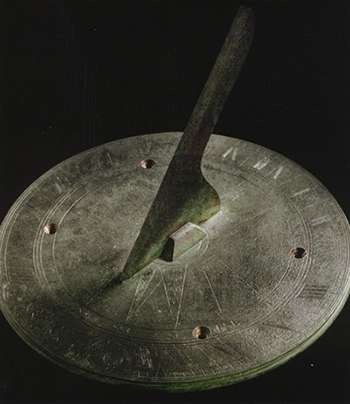 |
From early Saxon times to the Renaissance, church services alone kept time in most towns and villages throughout Great Britain, and medieval sundials were once commonly found on the walls of churches throughout the country. Today, of the 1,956 surviving vertically-fixed sundials so far recorded in Britain by the British Sundial Society, 60 per cent are to be found on ecclesiastical buildings. (1) Surviving sundials are often delightfully ornamented, but many are worn almost beyond recognition, recording the passage of time in a manner never intended. Many more have been lost altogether, some through theft, others as a result of their steady erosion by the elements and decay, making those that survive all the more precious.
SUNDIAL TIME
It should be said that the sundial is not a form of clock. It is an astronomical
instrument which enables the time to be determined from the apparent motion
of the sun. An indicator, called a gnomon or style, casts a shadow or projects
a spot of light (by means of a nodus), onto a graduated surface, the dial-plate,
indicating the hours of the day.
The time given by a sundial is local apparent time (LAT) which differs from
local mean time (LMT) by an amount known as
the equation of time. This difference
is caused partly by the varying speed at which the earth travels in its
path around the sun, and partly by the fact that the earth's axis is tilted
some 231/2 degrees to the plane of its orbit. The
difference can be applied, as a simple correction to the reading obtained
from the sundial.
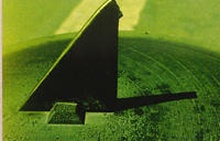 |
||
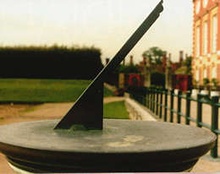 |
||
| The reconstruction of a broken gnomon on a late 17th century sundial at Hampton Court, before and after restoration The upper section of the gnomon on this double horizontal brass sundial (by Thomas Tompion, c1690) had been broken off. When it was restored, this section was missing, so the gnomon had to be reconstructed to a design of the same proportions as the original and scarfed in place. As the only photograph of the sundial in its original state was one poor quality illustration from a magazine which showed the dial from a bad angle, the exact form of the gnomon was unknown. However, some years later the original missing section was discovered, and the reconstruction piece was found to be a remarkably satisfactory replacement. Nevertheless, in the interests of authenticity, the original was scarfed back into position, with only a small piece of the reconstruction remaining. (6) Restored by Plowden & Smith for English Heritage, 1988 | ||
 |
||
| Reconstruction of an 18th century horizontal bronze sundial at Killerton House, Devon The original sundial made by Benjamin Martin c1784 had been stolen. Fortunately, in this particular case, there were some quite good photographs of the sundial, including colour close-up pictures of the dial-plate and signature. By measuring the diameter of the circular mark remaining on the pedestal, it was possible to determine the diameter of the instrument. Then, by photogrammetric methods, the dimensions of the original were established. This having been achieved, the delineation of the dial-plate was calculated for the given latitude (of Killerton House), and an exact drawing was commissioned to reproduce the original in every detail. (7) Restored by Plowden & Smith, 1999 |
A permanent correction is also required to allow for the difference in longitude
from the standard meridian (Greenwich). Only then can we ascertain the standard
mean time - that is to say, the standard 'clock' time adopted throughout
the UK, which is Greenwich Mean Time (GMT) or, in the summer, British Summer
Time.
The invention of the system of equal hours and of a sundial that consistently
indicated such hours is attributed to Islamic science, probably to Arabic
mathematicians of the 10th and 12th centuries. This form of sundial may
have been introduced into Europe through Moorish scientific and cultural
influence in Spain, or perhaps through contact resulting from the Crusades.
The earliest sundials in the United Kingdom include finely sculpted Anglo-Saxon
'sundials' and the later medieval mass dial. Mass dials are frequently referred
to as 'scratch' dials, since more often than not they are found crudely
scored into the stonework, adjacent to the south porch of a church, or otherwise
on the southern aspect of the building. They were almost certainly the work
of individual priests, although some of the better examples may have been
carved by stonemasons.
These early precursors of what may be called the scientific sundial are
not accurate, since they employed a short, horizontal gnomon in the form
of a wooden peg or perhaps a metal rod which projects perpendicularly from
a hole in the wall at the centre of the dial. They indicate unequal, seasonal,
or 'temporary' hours, specifically canonical hours, as kept by the Church,
and would only show the correct time at midday. The 'modern' scientific
sundial normally employs an inclined gnomon, parallel to the polar axis
of the earth, being constructed for a specific latitude, and indicates equinoctial
or equal hours throughout the year. Thus, the Anglo-Saxon 'sundial' and
the medieval mass dial are not classified as 'scientific' sundials within
the meaning of the term. (2)
In the 13th century mechanical clocks which sounded and showed 24 equal
hours came into use. Such clocks were complementary to the 'scientific'
sundial but were unreliable and required regulation by a reliable means.
It was the 'modern' sundial that served this purpose. The first 'modern'
European sundial seems to have appeared first in Germany, probably in Erfurt,
in about the year 1345 or later, about 1425. Certainly, by the end of the
15th century, the scientific sundial was well-established as an instrument
for determining the time by the equal hours system.
Thus, in the following centuries, clocks and sundials flourished side by side. (3) Some later sundials were even formed within the stained glass windows of churches. Such sundials mainly date from the 17th century, when glass painters had to diversify to off-set the loss of religious glass painting, resulting from puritanical purges.
Only with the arrival of the railways in the early 19th century and the introduction of the electric telegraph, providing rapid communication and the ability to transmit time-signals from astronomical observatories, did the importance of the sundial begin to wane. Not until some 30 years into the 20th century, however, was it finally eclipsed as a scientific instrument for determining time. (4)
CATEGORIES AND CLASSES
Sundials take many different shapes and forms, quite apart from the common or garden horizontal dial that most people visualise when the subject is mentioned. Sundials fall into two main categories, namely fixed sundials, usually found outside, attached to a building or mounted on a pedestal, and portable sundials, which are now mostly collectors' pieces or in museums.
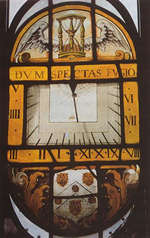 |
|
| Restoration of a missing gnomon to a vertical declining stained and painted glass 17th century sundial (c1669) at Weavers House, New Wanstead, London: The sundial had been removed from its original site in the Hall of the Worshipful Company of Weavers, in the City of London, sometime about the year 1916, when German Zeppelin air-raids threatened to destroy the building. It had been 'lost' in store in the Company's New Wanstead premises until a search was instituted, shortly prior to its restoration in 1988. It was cleaned and restored with a new brass gnomon (fitted to a brass frame), and set up in the new extension of the Weavers House, at New Wanstead, in a window that had been specially constructed to allow for the sundial's original declination. (9) Restored by Plowden & Smith, 1988 | |
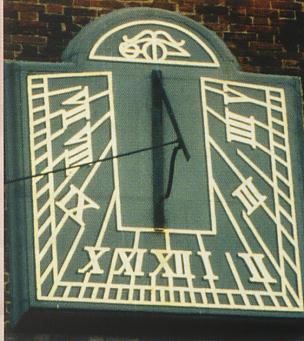 |
|
| Restoration of a vertical declining (South 5o East) stone 18th century sundial, (c1731) at the Castle Bromwich parish church of St Mary & St Margaret, Birmingham: Whilst removing the loose and friable paintwork from a plain black and white sundial, typical of the late 18th and early 19th centuries, the remains of an earlier sundial were found beneath the later paintwork. This transpired to be an unusual dial, painted in an artistic style that appeared to represent a transitional stage between the ornate fashion of the 17th century and the plain, utilitarian manner of the 18th century. Of particular interest was the curious layout of the dial-plate in which the numerals were axially aligned with the hour-lines, as opposed to being placed vertically in a rectangular border. The declination of the wall on which the sundial was situated was determined, the delineation of the original sundial was established, and the gnomon was adjusted slightly to conform with this arrangement. The paintwork of the dial was also analysed and the sundial was duly restored to its original resplendent state, painted with a blue/grey background, with gilded numerals and hour-lines, the leading edges of which were highlighted with black shadow relief. Whilst this achievement owes much to specialist teamwork, it must primarily be a tribute to the analytical science of the conservator in determining the original paints that were used. (8) Restored by Hesp & Jones, further to a report by The Perry Lithgow Partnership, commissioned by Rodney Melville & Associates, Conservation Architects, 1988 |
Fixed sundials are divided into various primary and secondary classes. The
primary classes of sundials include horizontal, vertical, equinoctial and
polar dials. Vertical dials lie in the vertical plane, facing directly north,
south, east, or west; equinoctial sundials lie in the plane of the equinoctial
(the celestial equator); and polar dials lie in the plane of the polar axis
of the earth. The equinoctial sundial, usually to be found in the form of
an armillary dial made up of a number of rings, is the most basic sundial
from which all others are derived. The secondary classes of sundial are
those that vary from the main classes, that is to say vertical sundials
that decline from the cardinal points of the compass, sundials that incline
from the horizontal, and multiple sundials made up of numerous individual
component dials.
The sundials most commonly found in churchyards are those of the common
horizontal class, normally made of brass or bronze, although, sadly, many
of these have been stolen in recent years or have been badly damaged. In
the churchyard of St Mary's at Elmley Castle in Hereford and Worcester there
are two exceptions to this in the shape of two early stone multiple dials.
Although they have been restored over the years, most recently in 1971,
they are possibly the earliest surviving dials of their kind, thought to
date from about 1545. One of these sundials in particular, close to the
pathway approach to the church, is a very fine example of this class of
sundial, and few other examples are known in England.
The most common sundials to be attached to ecclesiastical buildings are
vertical dials of both the primary and secondary classes. However, many
have been allowed to decay or have been taken down, never to be seen again.
In the words of Major General Prynne, of the Society for Nautical Research,
in an address on the subject of the Grace Dieu: 'It is regrettable that
among our less admirable national characteristics are the indifference to
and neglect of our national treasures'. (5) Perhaps, within the last 30 years,
there has been some slight change in this attitude, although, in the case
of the sundial, long since disregarded as the means of regulating the church
clock, it is largely too late.
THE CONSERVATION, RESTORATION AND RECONSTRUCTION OF SUNDIALS
Conservation may be described as 'repairs, remedial work and other acts
carried out to ensure the preservation of the material structure of an object
in shape or form'. Where an object has deteriorated or been damaged, restoration
- that is to say, the act of restoring the object to its earlier or original
state, so far as may be possible - generally comes within this discipline.
However, conflicts arise between the need to preserve all historic fabric
unaltered and the desire to restore instruments like clocks and sundials
which we expect to work according to the principles by which they were originally
constructed. Simply preserving an illegible piece of stonework that is known
to be a sundial may not be enough. We preserve the fabric of a building
as best we can; but, if needs must, sections of the building have to be
replaced with new building materials. How else could one preserve an historic
building, such as the Tower of London, in its entirety? Consequently, it
may be preferable to restore a sundial, rather than simply to preserve it
in its current state.
Restoration could not be justified in the case of a finely worked Anglo-Saxon
'sundial' or a medieval mass dial, due to the age and rarity of the originals
and because to restore the face would involve cutting into the very fabric
of the building itself. (There is a stone-mason who is on record as saying
how much pleasure he has received from going around churches, re-incising
their mass dials!) However, there may be a case for removing a deteriorating
original to the interior of the church or to a museum where it can be preserved
and displayed. A replacement can then be made for the original either as
an exact replica or, where the original design cannot be established with
any degree of certainty, as an honest, modern alternative design.
Obviously, each case must be judged on its own merits and the principles of preservation should be adhered to, so far as this is reasonably possible.
All too often components are missing altogether, such as the gnomon or the dial-plate, requiring the design of a replacement. New design may be based on any available records of the original or other examples of the designer but, failing this, the replacement may have to be simply in the style of the period.
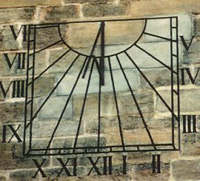 |
|
| A simple, late 17th/early 18th century mural sundial at Ripon Cathedral, Yorkshire: Evidence was found of at least two previous restorations with marked 'drifting', resulting from years of periodic over-painting. The dial was restored with incised hour-lines and numerals, painted in black. Whilst the original dial-plate would almost certainly have been painted as well, in a contrasting colour, probably in white as was the custom, the stonework was left in its natural state at the request of the authorities. The missing metal gnomon was reconstructed to a simple period design, also painted black. In this case there were no available photographs or illustrations to support the restoration. (10) Restored by Brookbrae Limited in 1992 | |
 |
|
| Vertical
stone 17th century-style sundial at HM Tower of London Whilst the remains of the original Portland stone dial-plate were
still in place in this example at the Tower of London, there was no
gnomon and no trace of any surface markings. Furthermore, there were
no photographs, illustrations or records of the original sundial,
to which one could refer. It was therefore decided to fix a new stone
dial-plate, reconstructed to a 17th century design calculated as a
direct south dial, over the original so as not to disturb the existing
fabric. The dial-plate was incised with the required delineation on
site, and painted white, with gilded hour-lines, numerals and embellishments.
The new gnomon was given a simple rectangular section with a double
support. Initially, English Heritage was reluctant to allow the sundial
to be painted and gilded, preferring the effect of natural stone;
but the historical arguments for this treatment were duly accepted. Restored by Plowden & Smith, commissioned by the Department of the Environment, to the advice of English Heritage, 1988 |
Vertical dials are less likely to be stolen from properties than horizontal
sundials. This is because they are usually out of the immediate reach of
a prospective thief; they are normally very much larger than the common
horizontal dial; and they are seldom made of metal (with the exception of
the gnomon). Thus the vertical sundial is a rather less attractive proposition
when it comes to selling it on 'down the line'. However, vertical sundials
are often high above the ground where they are more exposed to the elements,
making maintenance difficult and leaving them more prone to decay. Consequently,
the reconstruction of a vertical sundial is usually required for reasons
other than theft or damage due to deliberate force.
Repairs often involve the re-delineation of the dial-plate to restore hour-lines
and numerals to their original layout, as in the case of a vertical sundial
where years of over-painting has caused obvious 'drifting'.
The few examples given here will suffice to illustrate the kind of cases
that involve a requirement for sundial reconstruction design as well as
some of the problems that may be encountered in the course of a restoration
programme that includes a sundial. There are, of course, many historic sundials
that are in various states of disrepair and it is to be hoped that, for
the most part, they will be restored whilst the visible details of the dials
are still extant.
To this end, the British Sundial Society is endeavouring
to monitor such sundials with a view to encouraging their restoration and
conservation. This is an onerous task at the best of times and, ultimately,
the responsibility for accomplishing this aim must rest with the owners.
Nevertheless, the Society has within its membership a wide range of specialist
knowledge and technical experience, including skilled conservators and restorers.
Thus, much professional expertise in this field is readily available; but
those concerned with historic building projects involving a sundial are
often inclined to take a simplistic view of the situation, perhaps to save
costs on something that is considered to be of secondary importance. It
must be said that this is a short-sighted view. Whilst most people regard
sundials as simple, they are only simple to those who fully understand them.
By and large, as with most specialist matters, the best course of action,
if in doubt, is to seek professional advice.
In a recent issue of a popular home and interiors-type magazine the following
response is given in respect of a query from a couple in Kent who wish to
restore two vertical wall sundials: 'Collectors would not thank you for
restoring such items yourself, so call the British Furniture Restorers'
Association ... for advice, but you could try cleaning the sun dials with
a high pressure hose'. So much for 'professional' advice: words fail me!
Notes
1 British Sundial Society, The Sundial Register 2000 - Fixed
Dial Locations: A summary of records from the National Survey of the British
Sundial Society, 2000
2 Christopher St JH Daniel, Sundials, Shire Album 176,
Shire Publications, Princess Risborough, pp7-9, 2000
3 Ibid, p9
4 Ibid, pp3-4, p10
5 London Evening Standard, 20 September 1968
6 Christopher St JH Daniel, 'Conservation: The Restoration
of Sundials - Some Necessary Questions', The British Sundial Society Bulletin,
Vol 98/2, pp26-31, 1998
7 Christopher St JH Daniel, 'The Last Instruments?', Clocks, Vol 19/6, p30, 1996
8 Christopher St JH Daniel, 'Gut Feeling', Clocks, Vol 15/8, p47, 1993
9 Christopher St JH Daniel, 'Conservation: The Restoration
of Sundials - Some Necessary Questions', The British Sundial Society Bulletin,
Vol 98/2, pp26-31, 1998
10 Ibid, p1



